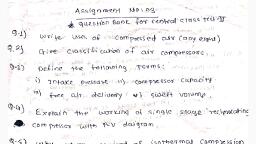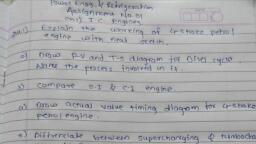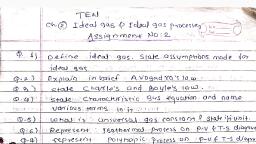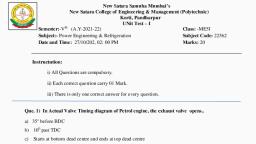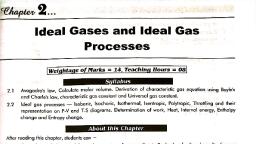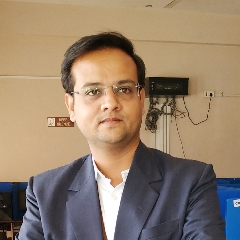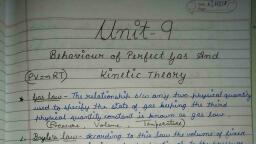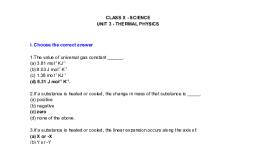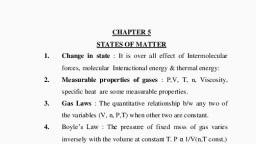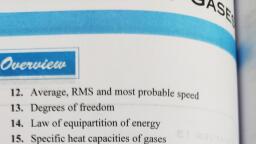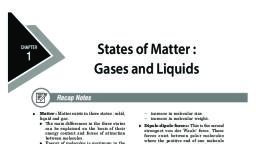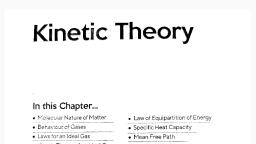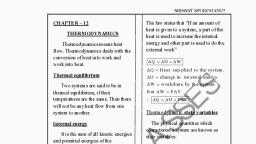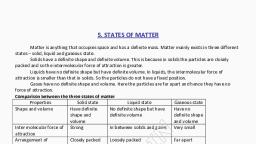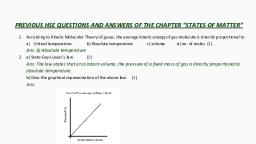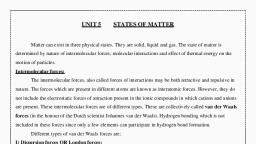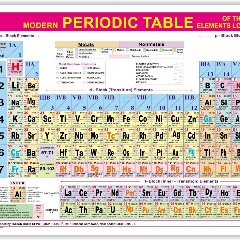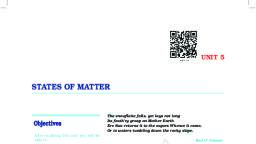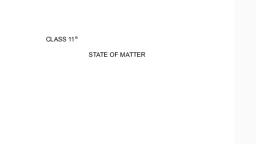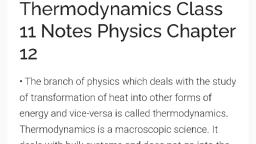Page 1 :
UNIT Il, , Ideal Gases and Ideal Gas Processes, , , , , , , , , , , , , , , , 24, , 2.2 Ideal gas processes :, , Avogadro's law, Calculate Molar Volume, Derivation, law, characteristics gas constant and universal gas c, , tsobaric, Isochoric, Isothermal, Isen\, on P-V and T-S diagrams. Determination of work, heat, int, , of characteristic gas equation using boyle's and Charle’s, onstant., , tropic, Polytropic, Throttling and their representation, ernal energy, enthalpy change and entropy change., , , , , , 21 Concept, , , , , , Q. _ Define ideal gas., , A hypothetical gas which obeys Boyle’s law and Charle’s law, and whose characteristic equation is obtained by the, combination of above law; PV = RT at all pressure and, , temperature is called as ideal gas., , There are three primary phases of a substance namely, solid,, liquid and gas., , -, Adcal gas is a gas which remains in gaseous phase at all, , pressure and temperatures. In actual practice there is no, , perfect gas in nature., Sees, , — But many gases can approaches to this standard within the, temperature limit. Oxygen, nitrogen, air are considered as, ao, perfect gas as they obeys these laws within the temperature, ee, , limit of thermodynamics. They are also known as réal gases., , A gas is a phase of a substance whose evaporation from its, , , , liquid phase is completed., Se, , = Assumptions Made for Ideal Gas., , , , eh, , , , , , -Q.’State the assumptions made for ideal gas., , , , —, , , , , , , , , , Following are the assumptions made for ideal gas, —_—__——, , a) A finite volume of gas contains large number of molecules., , b) The collision of molecules with one another and with the, , walls of the container is perfectly elastic., —, , c) — The molecules are separated by large distances compared to, , their own dimensions., , d) The molecules do not_exert forces on one another except, —_s, , when they collide., , As long as the above assumptions are valid the behaviour of a, , ~ teal gas approaches closely that of an ideal gas., a, Syllabus Topic : Avogadro’s Law, Calculate Molar, : Volume, SSS, , 2.1.1 Avogadro’s Law and molar volume, , , , , , , , , , Q. State Avogadro's law,, ‘|. Explain in brief Avoga d, , SSSR, , . EES, , Avogadro's law (sometimes referred to as Avogadro's, , , , , , , , hypothesis or Avogadro's principle) is an experimental gas, f, law relating volume of a gas to the amount of substance ©!, , aS present.
Page 2 :
PP thermat Engineering (MSBTE), , 2-2 Ideal Gases and Ideal gas processes, , , , << _ This law states that equal volumes of all ideal gases at the, , same temperature and pressure contain the same number of, —___, molecules., —, , OR, , — It states that volume of a ‘g’ mol of all gases at the pressure, of 760 mm and temperature of 0°C is the same and is equal to, 22.4 litres. Therefore, 1 g mol of a gas has a volume of, 22.4 x 10° cm’ and | kg mole, of a gas has a volume of, , 22.4 m‘ at the normal temperature and pressure (N.T.P)., , - Foracertain gas, if m is its mass in kg and 1 its molecular, , weight, then the number of kg moles of the gas, n would be, , given by,, mkg om, he Key kg moles, ¥ kg mol, Molar volume v is given by, Vv, ved m'/kg/mol, , where *V" is the total volume of the gas in m’., , 2.1.2 Charle's Law, , , , _Q. State Charle's law., , W-08. W-09, W-10, S:11, S-12. S-13,, a3 SaaS TESS Pa ease eee), , This law introduced by Charle’s in 1787 A.D. It states that “If, —_—_—, , , , , , , , , , a unit mass of a gas is maintained at constant pressure, the, volume of gas varies directly proportional to absolute, SS —, , temperature of gas”., , Ss, , According to this law,, Where V =, Te, , Volume of gas in m?, , absolute temperature of gas, , , , (t+273), As‘t’ temperature in °C, , , , TT = Constant, Pi T 2 T, Py, ioe i -273 LBZ, Vv s N,, ) ), , 2.1.3. Boyle's Law,, , , , , , Q. Define Boyie's law for ideal gas. EXEATEENSSIS, This law introduced by Robert Boyle’s in 1662 A.D. It states, that “If a unit mass of gas is maintained at constant temy erature,, , the volume (V) of gas varies inversely proportional with the, absolute pressure (P)”., , ‘4 T, 1——_>—2, Dye, v $s, ) “ &), , Fig. 2.1.2, , Pp., , (a, , I ‘, Vee p When temperature T is constant, , PV = Constant, , ie. suffix 1 is initial state and 2 is final state of gas, , P,V, = P,V, =Constant, , Isothermal process : When temperature is. constant then it is, , called Isothermal process., , Hyperbolic expansion : The expansion of a given mass of., , gas under PV = C is known as hyperbolic expansion., 2.1.4 Gay-Lussac Law, , — It States that “The absolute Pressure of a unit mass of gas, varies directly proportional to absolute temperature of gas”,, , When the volume of gas remains constant., , 2 T, 2, 1 1, Vv s, @) ), Fig. 2.1.3, Pe T, where V_ = Constant, Pe. PoP, T=2Cc> 7; ap ac
Page 3 :
Ideal Gases and Ideal gas processes, , , , , , , , Thermal Engineering (MSBTE) 2:3 :, eaaaeaEeESESySSaee_es_— ee Ny Na wl), Syllabus Topic : Derivation of Characteristic Gas T 2, , Equation Using Boyle’s Law and Charle’s Law, , Derivation of Characteristic Gas, Equation Using Boyle’s Law and, Charle’s Law (Equation of State), , 2.1.5, , Q. State characteristic gas equation arid ‘give units of, , DEEE, , Q. Write ideal gas equation and unit for “universal gas., , ee, , Q. Using Boyle's law and Charle's law. derive the, , Q. Write equation of state and name various terms used, , tH, , — The functional relationship among the properties, pressure P,, , , , each term in equation., ~ constant., characteristic equation for a perfect gas., , init., , , , molar or specific volume V and temperature T is known as an, , equation of state which may be expressed in the form,, F(P,V,T) = 0, — If two properties of a gas are known, the third can be, evaluated from the equation of state., , ~ To derive the equation of state for a perfect (Ideal) gas =, , (combination of Boyle’s law and Charle’s law), , — Let us consider a unit mass of an ideal gas to change it’s state, , in the following two successive processes. Refer Fig. 2.1.4., , , , Fig. 2.1.4 : Formulation of equation of state of ideal gas, (1) Process 1-2’ at constant pressure, (2) Process 2’- 2 at constant temperature., , For process | -2’, Apply Charle’s Law,, , YM, Toot, Since 1; = 7;, , Process 2 ~ 2’, using Boyle’s law, , PV; = P,V2, Since Pp = Pi, PV, = P22, yp asRNy ..Q), v=,, , From Equation (1), by substituting value of V2 a, P, Vy, P, T,, , Py V2, =F, , ;, , Constant, , , , = The magnitude of this constant depends upon the particular, gas and it is denoted by R, where ‘R’ is called the specific gas, , constant or characteristic gas constant., , PV, , T= R, , 1, , Thus the equation of state for a perfect gas is given by, , PV=RT, ‘m’' kg of mass occupying volume ‘V’ is m’ of., , PV = mRT, , , , , , Syllabus Topic : Characteristic Gas Constant and, Universal Gas Constant, , 2.1.6 Universal or Molar Gas Constant, , , , , , , , , , , , If mass is equal to molecular weight of the gas then one mole, of the gas have been considered i.e. 1 kg mole of oxygen is, 32 kg of oxygen or 1 kg mole of hydrogen is 2 kg of, , , , hydrogen.
Page 4 :
PY,, , °, , Vv, , °, , M, , MR, , PV,, , Since v, , PV, , N, PV, , PV, , R, , Forair, R, , , , 3, — The equation of state written as,, , — According to Avogadro that V,, is the same for all gases at the, , same pressure and temperature, therefore it may seen that, , R, is called molar or universal gas constant and its value is, , 8.3143 kJ/kg mol. °K., Tf ‘n’ moles present then ideal gas equation PV = nR.T., , From Avogadro's law for air when P = 760 mm of Hg, , Syllabus Topic : Ideal Gas Processes, , 2.2 Ideal Gas Processes, , _ The different thermodynamic processes of gases may be, , classified as follows =, , Molar volume, , Molecular weight of the gas, , aconstant = R,, , 1.013 x 10° Nim’, , 27B.AS °K andy = 22.4 m'/kgmol, 1.013 x 10°x 22.4, , 8314.3 Navkg mol °K, , 8.3143 kJ/kg mol °K, , x. then for ideal gas, , a where is molecular weight, L, , R,, Characteristic gas constant = i, , eo, , = 0.287 ki/kg°K, , sucal Gases arid ideal gas processes, , Classification of Ideal Gas Processes, , , , , , , , (a) Constant volume Process (or Isochoric), , , , , , (b) Constant pressure Process (or Isobaric), , , , , , (c) Constant temperature (or Isothermal), , , , , , (d) Frictionless adiabatic Process, (or Reversible adiabatic or Isentropic), , , , , , (e) Polytropic Process, , , , , , , , , , (f) Throttling or Restricted flow Process, , , , Fig. C2.1: Classification of ideal gas processes, , — The above processes (a) to (e) are considered to be reversible, non-flow processes and throttling process is an irreversible, , flow process., , a, , , , Syllabus Topic : Isochoric, , 2.2.1 Isochoric Process, (or Constant Volume Process), , , , Q. Represent Isochoric process on PV and T-S diagram., , Eo W:-08, W-11, S-13, S-14, S-15, W-14, W-16, , , , , , , , , , , , , , , , , , , , , , , , , , , , , , N, , , , © . @, : Fig. 2.2.1, — When a gas is heated in an enclosed vessel, its temperature, and pressure increase since there is no change in its volume,, therefore no work done by the gas. All the heat supplied is, stored within the gas in the form of internal energy, , , , , Mie, , eG.
Page 5 :
I)" Thermal Engineering (MSBTE), , 2-5, , , , , , (ly, , (2), , Consider ‘m* kg of gas being heated at constant volume from, , initial state | to 2., , P,, V, and T, are pressure, volume and temperature at initial, , state 1., , P,, V, and T, are pressure, volume and temperature at final, , state 2., By Gay - Lussac Law, , Volume remains constant. V, = V,=C, i.e. dV =0, , PeT, PP,, T = T,, , 2, , Work done = W = J PdV as dV =0, I, , WwW = 0, Heat supplied or heat transfer, , According to first law of thermodynamics, , dQ = dU+dW, , z 2 4g, , Jag = favs few, , 1 I 1, , Q2 = ()-u,)+W,,=mC, (1-7) +0, Q = mC,(T,-T,), , Therefore heat supplied is utilized to increase the internal, , energy of the gas., , G), , Change in enthalpy, , dH = dU+d(PV,), 2 2 2:, Integrating f dH = f dU + j d(PV,), 1 1 ‘I, , H,-H, = U;-U,+P,V)-P, V,, , = mC,(T,-T,)+mR (T,-7,), , For perfect gas, PV = mRT, c-c, = R, C, = C4R, H.-H, = mC,(T,-T,)+mR (T,-T,), , = m(T,-T,)(C,+R)= mC, (T,-T)), , , , 2.2.2, , (4) Change in entropy, , , , 2, w= [@, I, 2 2 2, Integrating Jas = J nee =mC, jz, 1 1 1, , , , 2 T;, S,-S, = mC, log], =m, te,( 7), 1, Ty P,, T = PB, P,’, AS = tos, 2), , SS, , , , Syllabus Topic : Isobaric, , Isobaric Process, (Constant Pressure Process), , , , Q. Represent lsobaric process on PV and T-S diagram., Q. Represent following process on P-V and T-S diagram :, , Q: Plot following process on P-V diagram,, , , , SUPA ESS aoa i 6, , (i). Isobaric process, , AEC A TASS A eee), , (i)-Constant pressure, , , , , , , , Saturation, line, , , , ©, Fig. 2.2.2, , When a gas is heated at constant pressure, its temperature and, volume will increase, since there is change in volume,, therefore the heat supplied to the gas is utilized to increase, internal energy of a gas and for doing external work., , 1) Work done by the gas or on the gas

